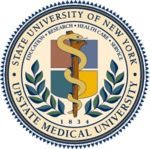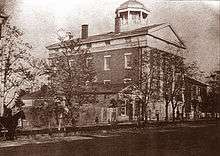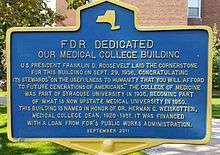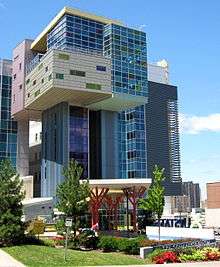State University of New York Upstate Medical University
 | |
| Motto | "Education, Research, Health Care, Service" |
|---|---|
| Type | Public |
| Established | 1834 |
| Endowment | US $40.2 million[1] |
| President | Danielle Laraque-Arena, M.D. |
Academic staff | 2424 (2017)[2] |
| Students | 1481 (2015)[2] |
| Location | Syracuse and Binghamton, NY, US |
| Campus | Urban, 30 acres (0.12 km2)[2] |
| Colors | blue and white |
| Affiliations | SUNY |
| Website |
www |
The State University of New York Upstate Medical University is a SUNY health sciences university located primarily in the University Hill district of Syracuse, New York. SUNY Upstate is an upper-division transfer and graduate college with degree programs within the College of Medicine, College of Nursing, College of Health Professions, and the College of Graduate Studies. Its Syracuse campus includes Upstate University Hospital.
In addition to affiliations with Binghamton Hospital and 22 other hospitals throughout central New York, where much of the core clinical teaching takes place, Upstate has numerous partnerships, including a joint Ph.D. Program in Biomedical Engineering with Syracuse University; science enrichment programs for local youth in tandem with the SC Hope Clinic; and SUNY-ESF.
It directly generates 9,849 jobs,[2] making it Onondaga County's largest employer.[3]
History


The present-day university's earliest predecessor was Geneva Medical College founded 1834 as part of Geneva College, today known as Hobart and William Smith Colleges. The new medical college was located in Geneva, New York, and became the first college to grant a full M.D. to a woman, Elizabeth Blackwell, in 1849. In 1871 the college was disbanded and its assets donated to the recently founded Syracuse University, which subsequently founded a medical college.
In 1950 Syracuse University sold the college to the State University of New York (SUNY), where it remains today. After carrying the names "SUNY Upstate Medical Center" (initially) and "SUNY Health Science Center at Syracuse" (1986), the institution was renamed to its present nomenclature in 1999.
A clinical campus in Binghamton, New York, was established in 1979.
A plaque in the lobby of Weiskotten Hall aptly describes one of the institution's driving philosophies: "Dedicated to all those of scientific mind and investigative spirit who purpose to serve humanity."
Campus
The university's main campus is located in the University Hill neighborhood of Syracuse, New York flanking Interstate 81. It includes Upstate University Hospital, the Institute for Human Performance, Setnor Academic Building, Central New York Gamma Knife Center, Jacobsen Hall, Regional Oncology Center, Upstate Golisano Children's Hospital, Weiskotten Hall, the Health Sciences Library, Silverman Hall and Geneva Tower residence hall. A clinical campus in Binghamton, New York was established in 1979. Medical students spend their first two years of medical school in Syracuse, New York and then approximately a quarter of the class completes their training in Binghamton.

Organization
Units of Upstate Medical University include:
- The College of Medicine is one of the oldest medical schools in New York. More physicians practicing in Central New York received their training here than at any other medical school. Upstate ranks eighth nationally for the number of graduates who are on the faculty at academic medical centers across the country.
- The College of Nursing offers a bachelor's degree for RN prepared nurses and graduate programs in: Pediatric Nurse Practitioner (MS), Family Nurse Practitioner (MS), Family Psychiatric Mental Health Nurse Practitioner (MS), and Doctor of Nursing Practice (DNP).
- The College of Health Professions is the gateway for students seeking to enter some of the most competitive and highly paid careers in health care today: Physician Assistant (MS), Physical Therapy (DPT), Cardiovascular Perfusion (MS), Medical Technology (BS and MS), Medical Biotechnology (BS), Radiation Therapy (BS and BPS), Respiratory Therapy (BS), Medical Imaging/Radiography (X-ray)(BS), and Ultrasound (BS and BPS).
- The School of Graduate Studies is known for its basic science education and research. Students have the opportunity to work side by side with neuroscientists and basic researchers.

- The university operates the Southern Tier Center on Aging in conjunction with the SUNY Binghamton.[4]
- On January 14, 2016, Dr. Danielle Laraque-Arena assumed the role of President of Upstate Medical University and is the first woman to lead the University.[5]
Notable alumni and professors
- Sir Frederick Nathaniel Ballantyne, M.D. - Governor-General of Saint Vincent and the Grenadines
- Elizabeth Blackwell, M.D. - First woman in the United States to be awarded the degree of Medical Doctor. Founder of The New York Infirmary, now Lower Manhattan Hospital.
- Marcus J. Goldman, M.D. - associate professor at Tufts University School of Medicine
- David B. Levine, M.D., Director of the Department of Orthopedic Surgery at Hospital for Special Surgery
- Patricia Numann, M.D. - Professor Emeritus of Surgery
- James B. Preston, M.D. - Professor and Chairman of the Department of Physiology
- Thomas Szasz, M.D. - Professor Emeritus of Psychiatry
- Sid Watkins, M.D. – Professor of Neurosurgery, 1962–1970; later became head of the Formula One on-track medical team
- Thomas Bramwell Welch, M.D. - British–American minister and dentist.
References
Notes
- ↑ As of June 30, 2009."U.S. and Canadian Institutions Listed by Fiscal Year 2009 Endowment Market Value and Percentage Change in Endowment Market Value from FY 2008 to FY 2009" (PDF). 2009 NACUBO-Commonfund Study of Endowments. National Association of College and University Business Officers. Archived from the original (PDF) on December 14, 2017. Retrieved February 19, 2010.
- 1 2 3 4 "SUNY Upstate Facts at a Glance," Upstate website. Accessed: 26 June 2018.
- ↑ Center State Corporation for Economic Opportunity. (2010, November), "Major Employers in Onondaga County." Onondaga County website. Accessed: 1 July 2018.
- ↑ "Southern Tier Center on Aging". SUNY Binghamton. Retrieved 2010-10-17.
- ↑ "Meet Upstate Medical University's Next Leader and Her Agenda for Patient Care and Research". WAER Syracuse Public Media. Retrieved 2016-04-07.
Further reading
- Luft, Eric von der (2005). SUNY Upstate Medical University: A Pictorial History. North Syracuse, New York: Gegensatz Press. ISBN 1-933237-34-1.
External links
| Wikimedia Commons has media related to State University of New York Upstate Medical University. |
Coordinates: 43°02′29″N 76°08′23″W / 43.04139°N 76.13972°W
